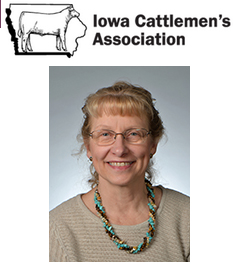Denise Schwab, interim IBC director column

September 2024
With the days getting shorter, it’s time to make plans for weaning this year’s calf crop. Weaning may be the most stressful time in a calf’s life – they are removed from momma, their feed changes, and their home changes all at once, so everything we can do to reduce stress is beneficial, but the process needs to start long before weaning day.
First, set your calves up for a healthy immune system by vaccinating them at least 2-3 weeks prior to weaning. Work with your herd veterinarian on both vaccines and timing. If utilizing a branded marketing program, check the requirements now. Many, including Iowa’s Green Tag program, require specific vaccinations, parasite control and castration and dehorning.
Second, help them adapt to a new nutritional program prior to weaning. If they will be backgrounded in a drylot, consider starting on creep feed 2-3 weeks ahead of weaning. Introduction of creep feed allows for a smoother transition to eating from a bunk and a new type of diet. If they will be weaned and backgrounded on pasture, plan ahead on which pastures will be best in terms of fencing, water source and high-quality forage. If calves have only drank from creeks or ponds their entire life and are expected to utilize an automatic waterer after weaning, allow them to learn that behavior before weaning.
Third, plan for the environment that calves will be moved into at weaning. If they spent their entire life on green pastures, weaning into a dry lot is a shock to their system. If possible, acclimate the calves into the drylot along with the cows for a couple weeks prior to weaning. Or better yet, wean them on the pasture and move the cows. Fenceline weaning where calves can see and hear momma has proven beneficial but does require a good fence between them. Recommendations include a tight, 4+ strand fence reinforced with woven or electric wire, and an area long enough so pairs can spread out and maintain relatively close proximity to each other. Typically, the calves will start to leave the common fenceline within a couple days with the cows taking a couple more days to leave the area. Within 5-7 days they should be ready to move to a new pasture away from each other. A three-year study from California showed that fenceline-pasture weaned calves spent more time eating, less time vocalizing and had higher daily gains than calves where the mothers were totally separated or calves were weaned into drylots. Fenceline-pasture weaned calves gained 95% more weight in the first two weeks than calves in all other weaning methods, and they were still heavier 10 weeks later.
When weaning into a drylot situation, ensure at least 1-1/2 ft/hd of bunk space. Check that bunk and water tank height can be accessed by small calves. When weaning on to dry feed, having long stem grass hay available for the first couple days with a corn by-product or grain mix sprinkled over the top typically will draw them to the bunk. Hand feeding twice a day will encourage calves to come to the bunk and aid in identifying sick animals or those not eating yet.
The more you do to reduce the stress of weaning, the more weight available to sell or transfer into your feedyard. Either way it is money in your pocket.
A few of our September programs to attend include two virtual fencing demonstrations on September 10 at 5 PM at 11879 Birch Ave, Breda, and September 11 at 10 AM at 7128 52nd Ave W, Colfax; the Sudangrass field day September 12 at 1 PM at the Kirkwood Community College Tippee Beef Center, Cedar Rapids; the Fencing & Grazing Clinic September 20, 9 AM at the Western Research Farm, 36515 Hwy E34, Castana; and the corn residue grazing field day on September 24 at 10 AM at the Southwestern Community College in Creston. More information on all these events can be found at www.iowabeefcenter.org.The IBC at Iowa State University serves as the university’s extension program to cattle producers. Our center comprises a team of faculty and staff from the College of Agriculture and Life Sciences, the College of Veterinary Medicine and Iowa State University Extension and Outreach. We work together to develop and deliver the latest in research-based information to improve the profitability and vitality of Iowa’s beef industry. If you’d like to be notified of updates on progress of research projects or programs that might be coming to your area, please subscribe to our “Growing Beef” newsletter by following the link on our website, www.iowabeefcenter.org. If you have a question, use our “Ask our Experts” link. Also, feel free to call us at 515-294-BEEF or email us at beefcenter@iastate.edu. You can follow @iowabeefcenter on Facebook, Twitter, YouTube and Instagram.
